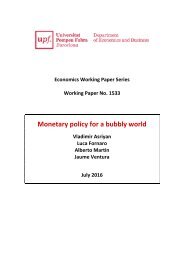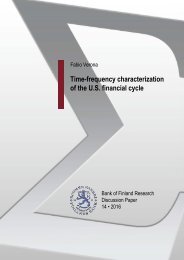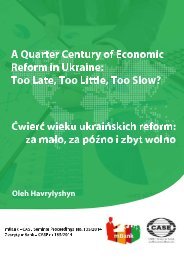Necessity as the mother of invention monetary policy after the crisis
n?u=RePEc:dnb:dnbwpp:525&r=mac
n?u=RePEc:dnb:dnbwpp:525&r=mac
Create successful ePaper yourself
Turn your PDF publications into a flip-book with our unique Google optimized e-Paper software.
Churm, R., M. Joyce, G. Kapetanios and K. Theodoridis (2015), ‘Unconventional <strong>monetary</strong> policies<br />
and <strong>the</strong> macroeconomy: The impact <strong>of</strong> <strong>the</strong> United Kingdom’s QE2 and Funding for Lending<br />
Scheme’, Bank <strong>of</strong> England Staff Working Paper No. 542.<br />
Claessens, S., L. Laeven and E. Cerutti (2016). ‘The use and effectiveness <strong>of</strong> macroprudential<br />
policies,’ Journal <strong>of</strong> Financial Stability, forthcoming.<br />
Coibion, O., Y. Gorodnichenko and J. Wieland (2012). ‘The optimal inflation rate in New Keynesian<br />
models: Should central banks raise <strong>the</strong>ir inflation targets in light <strong>of</strong> <strong>the</strong> zero lower bound?’ Review<br />
<strong>of</strong> Economic Studies, 79(4), 1371-1406.<br />
Conti-Brown, P. (2015), ‘The Twelve Federal Reserve Banks: Governance and Accountability in<br />
<strong>the</strong> 21st Century,’ Rock Center for Corporate Governance at Stanford University Working Paper<br />
203.<br />
Crowe, C. and E. Meade (2008), ‘Central bank independence and transparency: Evolution and<br />
effectiveness’, European Journal <strong>of</strong> Political Economy, 24, 763-777.<br />
Cukierman, A. (2013). ‘Monetary <strong>policy</strong> and institutions before, during, and <strong>after</strong> <strong>the</strong> global<br />
financial <strong>crisis</strong>,’ Journal <strong>of</strong> Financial Stability, 9, 373–384.<br />
Cukierman, A., S.B. Webb and B. Neyapti, B. (1992). ‘Me<strong>as</strong>uring <strong>the</strong> independence <strong>of</strong> central banks<br />
and its effects on <strong>policy</strong> outcomes’, The World Bank Economic Review, 6, 353–398.<br />
Davig, T. and R. S. Gürkaynak (2015). ‘Is optimal <strong>monetary</strong> <strong>policy</strong> always optimal?’, International<br />
Journal <strong>of</strong> Central Banking, 11, 353-384.<br />
de Haan, J. and S.C.W. Eijffinger (2016). ‘The political economy <strong>of</strong> central bank independence,’<br />
forthcoming in: R. Congleton, B. Gr<strong>of</strong>man and S. Voigt (eds.), Oxford Handbook <strong>of</strong> Public<br />
Choice, Oxford: Oxford University Press.<br />
de Haan, J. and J. Sturm (2016). ‘Central bank communication: How to manage expectations?’,<br />
forthcoming in: Mayes, D., P. Siklos and J-E. Sturm (eds.) Handbook on <strong>the</strong> Economics <strong>of</strong> Central<br />
Banking, Oxford: Oxford University Press.<br />
Drehmann, M., C. Borio and K. Tsatsaronis (2011). ‘Anchoring countercyclical capital buffers: <strong>the</strong><br />
role <strong>of</strong> credit aggregates,’ International Journal <strong>of</strong> Central Banking, 7 (4), 89-239.<br />
Eggertsson, G. and M. Woodford (2003). ‘The zero bound on interest rates and optimal <strong>monetary</strong><br />
<strong>policy</strong>’, Brookings Papers on Economic Activity, 1, 193-233.<br />
Ehrmann, M. (2015). ‘Targeting inflation from below – how do inflation expectations behave?’,<br />
International Journal <strong>of</strong> Central Banking, 11, 213-249.<br />
Ehrmann, M., S.C.W. Eijffinger and M. Fratzscher (2012). ‘The role <strong>of</strong> central bank transparency<br />
for guiding private sector forec<strong>as</strong>ts,’ Scandinavian Journal <strong>of</strong> Economics, 114(3), 1018–1052.<br />
Engen, E.M., T. Laubach and D. Reifschneider (2015), ‘The macroeconomic effects <strong>of</strong> <strong>the</strong> Federal<br />
Reserve’s unconventional <strong>monetary</strong> policies’, Finance and Economics Discussion Series 2015-<br />
005. W<strong>as</strong>hington: Board <strong>of</strong> Governors <strong>of</strong> <strong>the</strong> Federal Reserve System,<br />
http://dx.doi.org/10.17016/FEDS.2015.005.<br />
Eser, F. and B. Schwaab (2016), ‘Evaluating <strong>the</strong> impact <strong>of</strong> unconventional <strong>monetary</strong> <strong>policy</strong><br />
me<strong>as</strong>ures: Empirical evidence from <strong>the</strong> ECB's Securities Markets Programme’, Journal <strong>of</strong><br />
Financial Economics, 119(1), 147-167.<br />
Feroli, M., D. Greenlaw, P. Hooper, F. Mishkin and A. Sufi (2016). ‘Language <strong>after</strong> lift<strong>of</strong>f: Fed<br />
communication away from <strong>the</strong> zero lower bound’,<br />
https://research.chicagobooth.edu/igm/usmpf/2016.<strong>as</strong>px<br />
Filardo, A. and B. H<strong>of</strong>mann (2014). ‘Forward guidance at <strong>the</strong> zero lower bound’, BIS Quarterly<br />
Review, March, 37-53.<br />
Gagnon, J., M. R<strong>as</strong>kin, J. Remache and B. Sack (2011), ‘Large-scale <strong>as</strong>set purch<strong>as</strong>es by <strong>the</strong> Federal<br />
Reserve: Did <strong>the</strong>y work?’, International Journal <strong>of</strong> Central Banking, 7, 3–44.<br />
Goodhart, C.A.E. and J.P. Ashworth (2012), ‘QE: a successful start may be running into diminishing<br />
returns’, Oxford Review <strong>of</strong> Economic Policy, 28(4), 640-670.<br />
Greider (1987), ‘Secrets <strong>of</strong> <strong>the</strong> Temple: How <strong>the</strong> Federal Reserve Runs <strong>the</strong> Country’, New York:<br />
Simon & Schuster.<br />
Hall, R.E. and R. Reis (2015), ‘Maintaining central-bank financial stability under new-style central<br />
banking,’ NBER Working Paper 21173.<br />
Hamilton, J.D., E.S. Harris, J. Hatzius and K.D. West (2015). ‘The equilibrium real funds rate: P<strong>as</strong>t,<br />
present and future,’ NBER Working Paper 21476.<br />
Hammond, G. (2012), ‘State <strong>of</strong> <strong>the</strong> art <strong>of</strong> inflation-targeting’, Centre for Central Banking Studies,<br />
Handbook No. 29.<br />
Jordá, O., M. Schularick and A. Taylor (2011), ‘When credit bites back: Leverage, business cycles<br />
43








